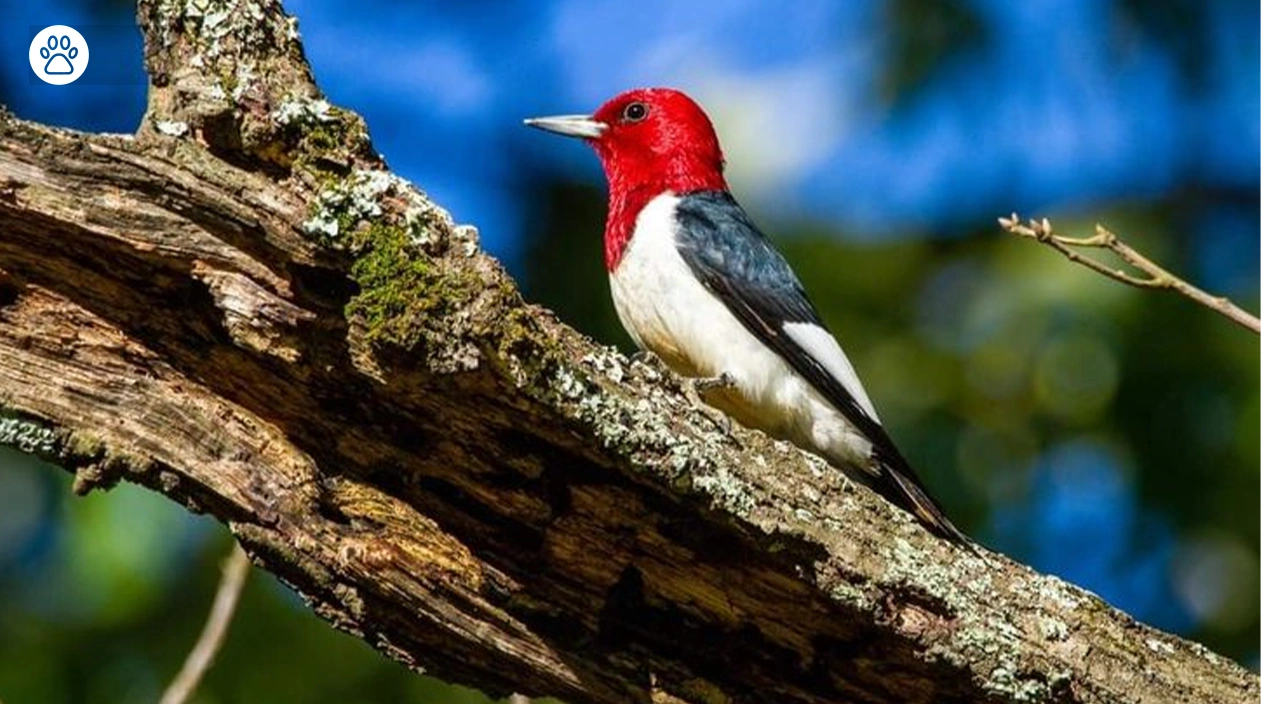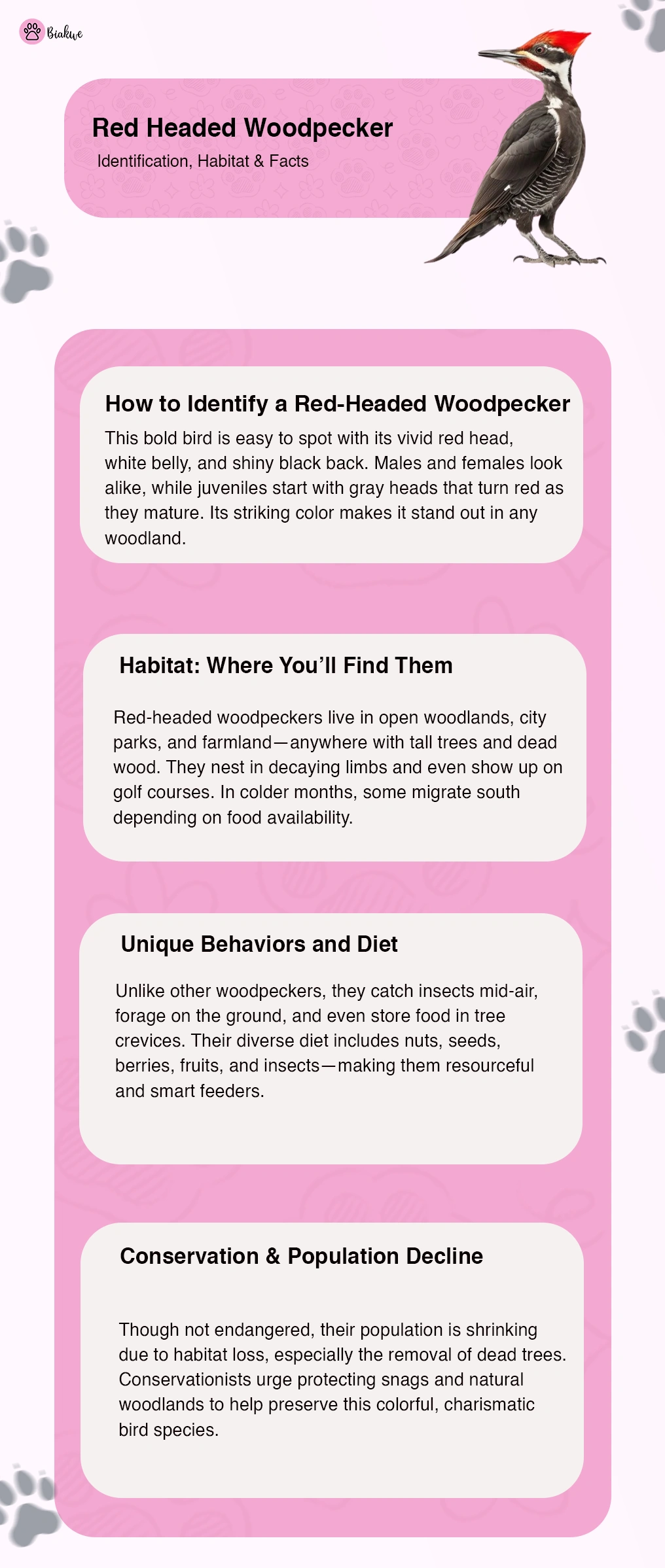Think of strolling in a sunny glade where the sound of a bird tapping away at something is echoing in the air. All of a sudden, a furious darting crimson glimpse comes into sight. A remarkably red woodpecker captures a glimpse of a nearby tree. Its intense head noticeably stands out from the rest of the forest.
“The red-headed woodpecker is a bold, conspicuous bird, easily recognized by its striking coloration and distinctive behaviors.”
In this article, the red-headed woodpecker is examined closely, describing everything, including its identifying marker and habitat, explaining everything about its particular attributes and the place it occupies.
What Do Red-Headed Woodpeckers Look Like?
What makes the red-headed woodpecker easily identifiable from other birds is their astonishing red head, white belly, and black back, which is black in status similar to a champion. The flying red woodpecker’s vibrant patterns are sure to catch sunlight.
Identical in appearance, females do not have any distinguishing features from males. Young red woodpeckers have less appealing gray heads which change into a red cap that joyfully completes the bird’s look, head, with age.
Visit: Personality and Bonding Habits: Are Black Cats Friendly?
Where Do Red Woodpeckers Live?
Woodpeckers with red heads prefer open spaces that have tall trees. They inhabit mountains, city parks, and even farms. These birds require dead or dying trees. That is where they build their nests and find food.
In addition to city parks, they can also be found on golf courses. If these locations have sufficient greenery and open areas, red headed woodpeckers can be spotted frequently. Some of them migrate south in search of food during winter, but a lot of them stay if food is plentiful.

Behavior and Diet
They exhibit a range of foraging behaviors. Unlike many woodpecker species that primarily excavate wood for insects, they are versatile feeders. They catch insects in flight, forage on the ground, and consume a variety of plant materials.
Their diet includes insects, spiders, earthworms, nuts, seeds, berries, and fruits. They are also known to store food in tree crevices, a behavior known as caching, which helps them survive during periods of scarcity.
Where do they Build Their Nests?
Red headed woodpeckers prefer to build their nests within decaying tree limbs. Trees that have some level of both softness and rot are usually chosen. The tree is also picked because the male and female red headed woodpeckers both sides of the tree to excavate its horizontal space.
Mother lays anywhere between three to ten eggs that are pure in appearance. The initial nurturing of the eggs is done by both parents. Chicks lose their shaggy feathers lifelong shack impression in around fourteen days, from then kids start getting sultans of the matter until flight readiness, this usually takes around four weeks but varies from three weeks and counting.

Are Red Headed Woodpeckers in Danger?
Even though red woodpeckers are still not close to being in danger, they are certainly experiencing a decline in their population. The main reason for the death of these birds is the number of dead trees left in the surrounding area. When dead trees are cleared from an area, it greatly hampers the number of birds that can thrive in that area.
Groups like All About Birds and Audubon The All About Birds group and Audubon have stated how crucial it is to preserve dead trees and forests. Unfortunately, the current trend in conservation efforts is ignoring tree stumps, which hinders aiding these birds.
Explore: A Guide to Black Smoke Maine Coons: Traits, Care and More
Migration: Do They Move Around?
It can be said that red-headed woodpeckers are, to some extent, migratory. While some prefer to stay in one area, most tend to move further south during the winter. This change is usually dependent on how much food is available in the region.
They are incredibly efficient at flying alone or within tight-knit groups. Unlike other birds who bounce around in the sky, red headed woodpeckers are direct in their flight path.
Fun Facts About Red Woodpeckers
They can be found everywhere thanks to their demand for being brilliant in color, but did you know that they also happen to be one of the leading food-storing woodpeckers usually found in North America?
Not many people are informed about the fact that woodpeckers can also be seen stealing food, but xаthey are known to also scavenge for meals.
They underwent an appellation change to flag birds due to their striking appearance they have, which makes them very easy to recognize.

Discover: Natural Pain Relief for Dogs: Safe Alternatives to Medication
Conclusion
The red headed woodpecker is not simply a bird with a red crown; it is truly captivating and a remarkable part of nature. This red woodpecker does not stand out in only one particular way, his food-preserving behavior is equally remarkable. His colors are striking, as are his impeccable manners. Unfortunately, it is losing its habitat, which has started becoming a problem.
We can make sure that birds with red heads can sustain themselves by protecting dead trees and planting red woodpeckers. Spotting one is a delight and surprise treat, and at any region of a forest, be it a backyard. So stay focused during your outdoor stroll, and do not miss the opportunity to encounter the stunning woodpecker.
